Stabilisatoren für die Maschinenstickerei spielen eine entscheidende Rolle bei der Erzielung schöner und professioneller Ergebnisse bei Ihren Stickprojekten. Egal, ob Sie Anfänger oder erfahrener Sticker sind, understanding the various types of stabilizers and how to use them effectively is essential. ;
In diesem umfassenden Ratgeber, Wir tauchen ein in die Welt der Stickstabilisatoren, ihre Bedeutung erforschen, verschiedene Typen, and the factors to consider when choosing the right stabilizer for your project. ;

Außerdem geben wir Ihnen wertvolle Tipps und Techniken, die Ihnen helfen, Ihren Stoff vorzubereiten und ihn für die Stickerei richtig zu stabilisieren, Beheben Sie häufig auftretende Probleme, und stellen Sie sicher, dass Ihre Stabilisatorsammlung ordnungsgemäß gelagert und gewartet wird.
Am Ende dieses Leitfadens, Sie erhalten ein umfassendes Verständnis für Stabilisatoren für Stickmaschinen und wissen, wie Sie diese zur Verbesserung Ihrer Stickkreationen verwenden.
Unlock the Secrets Of Machine Embroidery Stabilizers –; Ein definitiver Leitfaden
Was ist ein Maschinenstickstabilisator??
Stellen Sie sich einen Maschinenstickstabilisator als Rückgrat Ihres Stickprojekts vor. It’;Es ist ein Material, normalerweise aus Papier, Stoff, oder Vliesstoff, das dem Stoff während des Stickvorgangs Halt und Stabilität verleiht.
Von Verhinderung von Stoffverzerrungen, kräuseln, und verschieben, Stabilisatoren sorgen dafür, dass Ihr Design klar bleibt, sauber, und gut definiert.
Bedeutung von Stabilisatoren in der Maschinenstickerei
Stickmaschinen entfalten ihre Magie, indem sie mit hoher Geschwindigkeit komplizierte Designs auf Stoff nähen. Ohne Stabilisator, Der Stoff kann sich kräuseln oder dehnen, Dies führt zu unvollkommenen und enttäuschenden Ergebnissen.
Stabilisatoren bieten eine solide Grundlage für die Stickerei, So kann die Maschine präzise Stiche erzeugen und verhindert, dass sich der Stoff in der Nadel oder im Rahmen verfängt.
Zusamenfassend, Stabilisatoren sind das Geheimnis, das Ihre Stickerei vom Amateur zum Profi verwandelt.
Verschiedene Arten von Stabilisatoren für Maschinenstickerei verstehen
Nicht alle Stabilisatoren sind gleich, und unterschiedliche Projekte erfordern unterschiedliche Arten der Unterstützung. Here’;s a rundown of the most common types of stabilizers you’;werde begegnen:
Abreißstabilisatoren
Abreißstabilisatoren sind einfach zu verwenden und zu entfernen, Dies macht sie zu einer beliebten Wahl für Anfänger. Sie sind typischerweise dünn, Vliesstoffe, die leicht reißen, hinterlässt keine Rückstände auf dem Stoff.
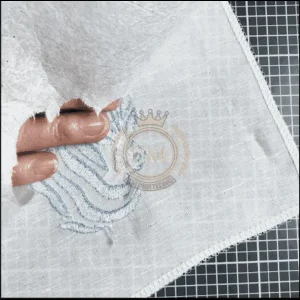
Geeignet sind Abreißstabilisatoren stabile Stoffe und Designs mit minimaler Stichdichte.
Schnittstabilisatoren
Ausgeschnittene Stabilisatoren sind langlebig und bieten lang anhaltenden Halt. Sie sind so konzipiert, dass sie nach dem Sticken im Stoff verbleiben, bietet Stabilität auch bei komplexen und dichten Designs.
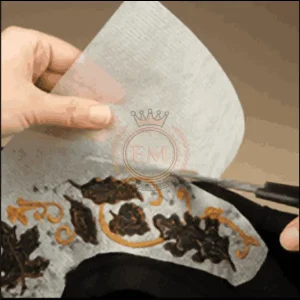
Ausgeschnittene Stabilisatoren sind ideal für dehnbare oder empfindliche Stoffe, die eine zusätzliche Verstärkung benötigen.
Auswaschbare Stabilisatoren
Abwaschbare Stabilisatoren lösen sich auf oder zerfallen, wenn sie Wasser ausgesetzt werden, hinterlässt keine Spuren.
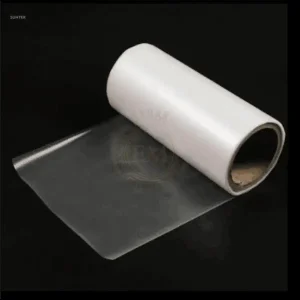
Sie eignen sich perfekt für Stoffe, die ihre Weichheit und Drapierbarkeit behalten müssen, wie Spitze oder transparente Materialien. Nach dem Sticken, Spülen Sie den Stoff einfach aus, um den Stabilisator zu entfernen.
Wärmeableitende Stabilisatoren
Wärmestabilisatoren verschwinden bei Hitzeeinwirkung, wie zum Beispiel mit einem Bügeleisen oder Heißpresse. They are excellent for fabrics that can’;Es darf nicht gewaschen werden, da es sonst schrumpfen kann, wenn es Wasser ausgesetzt wird. Wärmestabilisatoren sind eine praktische Wahl für Stoffe wie Samt, Samt, oder Kunstpelz.
Spezialstabilisatoren
Zusätzlich zu den oben genannten Haupttypen, Es gibt auch spezielle Stabilisatoren, die für bestimmte Zwecke entwickelt wurden.
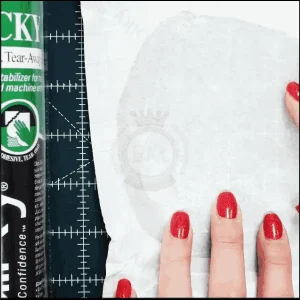
Beispiele hierfür sind selbstklebende Stabilisatoren zur einfachen Positionierung, lichtempfindliche Stabilisatoren, die bei Sonneneinstrahlung verschwinden, und selbst wasserlösliche Stabilisatoren mit zusätzlichen dekorativen Elementen wie Glitzer.
Wählen Sie den richtigen Stabilisator für Ihr Projekt
Es gibt so viele Stabilisatoroptionen, Wie wählt man das Richtige aus??
Berücksichtigen Sie diese Faktoren bei der Auswahl Ihres Stabilisators:
Berücksichtigung von Stoffart und -gewicht
Berücksichtigen Sie den Stoff. Empfindliche und dehnbare Stoffe erfordern stabilere und unterstützende Stabilisatoren, während robuste Stoffe möglicherweise weniger Verstärkung benötigen.
Bewertung der Designkomplexität
Die Komplexität Ihres Designs beeinflusst die erforderliche Stabilität. Dicht und komplex Maschinenstickerei-Designs benötigen einen stabileren Stabilisator, um Verzerrungen und Verschiebungen beim Sticken zu verhindern.
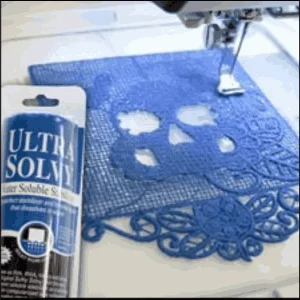
Beurteilung von Sticktechniken und -stilen
Verschiedene Sticktechniken, wie Applikationen oder freistehende Spitze, Möglicherweise sind spezielle Stabilisatoren erforderlich, um die gewünschten Ergebnisse zu erzielen. Consider the technique and style you’;was Sie bei der Auswahl Ihres Stabilisators verwenden.
Budget- und Verfügbarkeitsfaktoren
Stabilisatoren gibt es in verschiedenen Preisklassen, Berücksichtigen Sie daher bei der Auswahl Ihr Budget. Ebenfalls, Überprüfen Sie die Verfügbarkeit von Stabilisatoren in Ihrer Nähe oder online, um sicherzustellen, dass Sie den gewünschten Typ problemlos kaufen können.
Vorbereiten Ihres Stoffes und Unterlegmaterials zum Sticken
Now that you’;Wir haben uns für den perfekten Stabilisator entschieden, it’;Es ist Zeit, Ihren Stoff vorzubereiten und sich auf die Stickerei vorzubereiten.
Stoffvorbereitungstechniken
Bereiten Sie Ihren Stoff vor, indem Sie ihn vorher waschen und trocknen, um ein Einlaufen zu vermeiden. Das sanfte Bügeln des Stoffes sorgt für eine gestochen scharfe Stickerei.
Platzierung und Einspannen des Stabilisators
Abhängig vom Projekt und Stabilisatortyp, Legen Sie das Vlies vor dem Einspannen entweder unter oder auf den Stoff.

Durch die richtige Einspannung wird sichergestellt, dass der Stoff und das Stickvlies während des Stickvorgangs straff bleiben.
Befestigen des Stabilisators am Stoff
Um zu verhindern, dass sich das Vlies während des Stickens verschiebt, Befestigen Sie es mit Stecknadeln am Stoff, Clips, oder Klebesprays. Dadurch wird sichergestellt, dass der Stabilisator seine Aufgabe effektiv erfüllt.
Mit dem richtigen Stabilisator und der richtigen Vorbereitung, you’;Jetzt sind Sie bereit für Ihre Maschinenstick-Reise. So, Schnappen Sie sich Ihr Lieblingsdesign, Lade den Thread hoch, und lassen Sie Ihrer Kreativität freien Lauf!
Wartung Ihrer Stabilisatoren
Techniken zur Verwendung von Stabilisatoren in der Maschinenstickerei
Stickvliese sind so etwas wie die unbesungenen Helden der Maschinenstickerei. Sie bieten die nötige Unterstützung und Struktur, damit Ihre Designs makellos aussehen.
In diesem Abschnitt, wir werden abdecken einige wesentliche Techniken für den effektiven Einsatz von Stabilisatoren.
Grundlegende Stickstabilisierungsanleitung für verschiedene Stoffe
Just like how you wouldn’;Ich trage bei einer Wanderung keine Stilettos, Nicht alle Stoffe benötigen den gleichen Stabilisator. Bei der Auswahl Ihres Stabilisators, bedenke die Maschinenstickerei Stabilisatortabelle für Gewicht und Dehnbarkeit des Stoffes.
Leichtere Stoffe wie Seide benötigen möglicherweise einen leichten Stabilisator, während schwerere Stoffe wie Denim möglicherweise etwas Robusteres erfordern. Experimentieren Sie und finden Sie die richtige Kombination, um die besten Ergebnisse zu erzielen.
Überlagerte Stabilisatoren für zusätzlichen Halt
Manchmal, one stabilizer just isn’;t genug. Für zusätzliche Verstärkung, Versuchen Sie, verschiedene Arten von Stabilisatoren zu schichten.
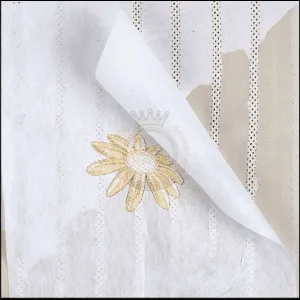
Die Kombination eines abschneidbaren Stabilisators mit einem abreißbaren Stabilisator kann die perfekte Balance zwischen Festigkeit und einfacher Entfernung bieten.
It’;Es ist, als würde man sowohl Hosenträger als auch einen Gürtel tragen – doppelter Halt, Verdoppeln Sie den Stil!
Anpassen von Stabilisatoren für bestimmte Stickeffekte
Stabilizers aren’;Es beschränkt sich nicht nur auf die Bereitstellung von Support; Sie können auch dazu beitragen, verschiedene Stickeffekte zu erzielen. Für einen 3D-Effekt, Verwenden Sie einen wasserlöslichen Stabilisator über Ihrem Design, darüber nähen, und dann abspülen.
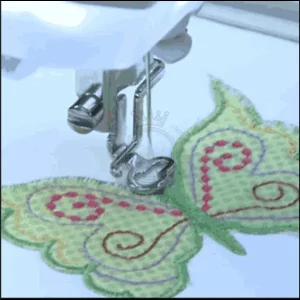
Oder, für ein spitzenartiges Aussehen, Versuchen Sie es mit einem Wärmestabilisator, der bei Hitzeeinwirkung verschwindet. Die Möglichkeiten sind endlos, so don’;Haben Sie keine Angst, kreativ zu werden!
Erkundung von Stabilisatoralternativen und -kombinationen
Stabilisatoren gibt es in verschiedenen Formen, Von herkömmlichen Folien über Sprays bis hin zu Optionen mit selbstklebender Rückseite. Jedes hat seine eigenen einzigartigen Eigenschaften und Verwendungsmöglichkeiten.
Don’;Scheuen Sie sich nicht, mit verschiedenen Kombinationen und Techniken zu experimentieren, um herauszufinden, was für Sie am besten funktioniert.
Schließlich, Stickerei ist sowohl eine Kunst als auch eine Wissenschaft!
Beheben häufiger Probleme mit Stabilisatoren
Stabilisatoren können Superhelden sein, aber auch sie haben ihr Kryptonit. In diesem Abschnitt, we’;Wir werden einige häufige Probleme untersuchen, die bei der Verwendung von Stabilisatoren auftreten können, und wie Sie diese wie ein Profi lösen können.
Techniken zur Entfernung von Stabilisatorrückständen
Haben Sie schon einmal ein wunderschönes Stickprojekt fertiggestellt und festgestellt, dass hartnäckige Stickvliesreste herumkleben??
Keine Angst!
Es gibt einfache Möglichkeiten, es zu entfernen. Vom sanften Abreißen bis zur Verwendung eines stoffsicheren Klebstoffentferners, Sie können sich von diesem lästigen Rest verabschieden und den wahren Glanz Ihrer Arbeit enthüllen.
Verhindert Stoffverschiebungen und Faltenbildung
Stoffverschiebungen und Faltenbildung beim Sticken können genauso frustrierend sein wie ein Bad-Hair-Day. Um dies zu verhindern, make sure you’;Verwenden Sie das für Ihren Stoff geeignete Vlies, es richtig sichern, und übermäßige Spannung vermeiden.

Mit diesen Schritten stellen Sie sicher, dass Ihr Stoff an Ort und Stelle bleibt und Ihre Stickerei faltenfrei bleibt.
Behebung von Fadenbruch- und Spannungsproblemen
Stellen Sie sich vor, Ihre Maschine tuckert fröhlich vor sich hin, nur um von a gestoppt zu werden Fadenbruch oder Spannungsproblem. Pfui, das Schlechteste! Aber keine Angst, liebe Stickerinnen.
Durch die Verwendung des richtigen Stabilisators, checking your machine’;s Spannungseinstellungen, und stellen Sie sicher, dass Ihr Thread richtig eingefädelt ist, Sie können diesen lästigen Rückschlägen ausweichen und Ihrer Kreativität freien Lauf lassen.
Umgang mit Problemen mit der Stabilisatorkompatibilität
Manchmal, Das Finden des perfekten Stabilisators für einen bestimmten Stoff und ein bestimmtes Design kann sich wie die Suche nach der Nadel im Heuhaufen anfühlen. Wenn Kompatibilitätsprobleme auftreten, Beispielsweise haftet der Stabilisator nicht richtig oder es kommt zu Verformungen, don’;Keine Sorge.
Versuchen Sie, das Gewicht oder die Art des Stabilisators anzupassen, oder erwägen Sie sogar die Verwendung einer anderen Technik. Erinnern, Beim Sticken geht es darum, herauszufinden, was für Sie am besten funktioniert.
Fazit: Beherrschung der Maschinenstickstabilisatoren für Stellar-Stickereien
Herzliche Glückwünsche, meine Stickbegeisterten! You’;Wir haben unser komplettes abgeschlossen Leitfaden für Maschinenstickstabilisatoren. Ausgestattet mit Ihrem neu gewonnenen Wissen, you’;Sie sind bereit, jedes Stickprojekt zu meistern, das Ihnen in den Weg kommt.
Also geh weiter, Erstellen Sie atemberaubende Designs, Und denken Sie daran, den unbesungenen Helden, die Stabilisatoren genannt werden, anerkennend zu nicken.
Viel Spaß beim Nähen!
EMdigitalisieren: Experte für die Digitalisierung von Stickereien zu Ihren Diensten
Wenn Sie an einem Stickprojekt jeglicher Art interessiert sind, Dann ist EMdigitizing die beste Option für Sie. Wir bieten Stickerei digitalisieren und Vektorkunstdienste mit einer schnellen Bearbeitungszeit. Sie können auch unsere Website besuchen und sich über unsere besten Dienstleistungen informieren.
Wir bieten auch ein tolles 50% Rabatt auf alle unsere Dienstleistungen für unsere angesehenen Erstkunden. Wir bieten auch an kostenlose Angebote in gerade erzeugt 5 Protokoll.
Schnappen Sie sich dieses zeitlich begrenzte Angebot und bringen Sie Ihr Stickprojekt mit EMdigitizing auf die nächste Stufe.
Wenn Sie Fragen zu diesem Thema haben, du kannst sie fragen. Vielen Dank, dass Sie sich die Zeit genommen haben, diesen Artikel zu lesen.
Häufig gestellte Fragen:
The best stabilizer for machine embroidery often depends on the fabric type and the design’;s Komplexität. Cut-away-Stabilisatoren werden aufgrund ihrer Haltbarkeit und Unterstützung allgemein empfohlen, insbesondere auf dehnbaren oder instabilen Stoffen, Dadurch eignen sie sich ideal für Designs, die häufig gewaschen oder getragen werden.
Zur Bestimmung des richtigen Stabilisators für Maschinenstickereien, consider the fabric’;s Gewicht, Textur, und dehnen, as well as the embroidery design’;s Dichte. Leichte Stoffe erfordern im Allgemeinen ein abreißbares oder abschneidbares Vlies, während schwerere Stoffe möglicherweise gut mit leichteren Stabilisatoroptionen funktionieren. Empfehlenswert ist ein Test an einem kleinen Stoffstück.
Stabilisatoren für die Maschinenstickerei gibt es in verschiedenen Ausführungen, inklusive Tear-Away, weggeschnitten, wegwaschen, und Hitze-weg. Abreißstabilisatoren lassen sich leicht entfernen, Aussparungen bieten mehr Halt für dehnbare Stoffe, Zum Abwaschen in Wasser auflösen, und durch Hitzeeinwirkung verschwinden sie durch Wärmeeinwirkung.
Choosing the “;better”; stabilizer is subjective and depends on the project’;s Bedürfnisse. Ausgeschnittene Stabilisatoren bieten den größten Halt und eignen sich hervorragend für Designs mit hoher Dichte auf dehnbaren Stoffen, während abreißbare Stabilisatoren ideal für schnelle Projekte auf stabilen Stoffen sind. Auswaschbare Stabilisatoren eignen sich perfekt für empfindliche oder transparente Stoffe, bei denen der Stabilisator vollständig entfernt werden muss.
Allgemein, Stickstabilisatoren sind nicht wiederverwendbar, da sie während des Stickvorgangs Unterstützung bieten sollen und entweder entfernt werden oder Teil des Projekts bleiben. Jedoch, Überschüssige Stabilisatorstücke aus abgeschnittenen Materialien können manchmal für den Einsatz in kleineren Projekten zusammengesetzt werden.
